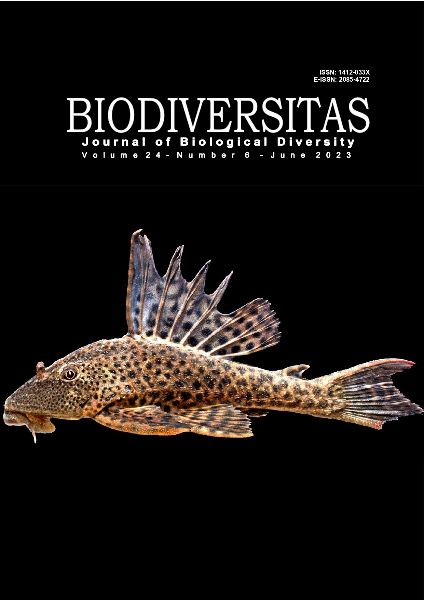Heavy metal content in duck eggs and meat that consumes feed containing Sapu-sapu fish (Hypostomus plecostomus)
##plugins.themes.bootstrap3.article.main##
Abstract
Abstract. Asnawi. 2023. Heavy metal content in duck eggs and meat that consumes feed containing Sapu-sapu fish (Hypostomus plecostomus). Biodiversitas 24: 3201-3206. This study aimed to evaluate heavy metals in the eggs and meat of ducks feeding on the Sapu-sapu fish (Hypostomus plecostomus Linnaeus, 1758) on Lombok Island, West Nusa Tenggara, Indonesia. The observation of collected Sapu-sapu fish samples from three major Mataram rivers. Duck eggs and meat were collected from a livestock group that fed Sapu-sapu fish. The observed variables include; macronutrients (moisture content, crude protein, crude fat, crude fiber, and ash) and heavy metal content (Cu and Pb) in the Sapu-sapu fish, duck meat and eggs fed by Sapu-sapu fish. The study found that the Sapu-sapu fish possesses complete macronutrients, making it a possible duck feed. The heavy metal content of copper (Cu) in the Sapu-sapu fish ranges from 189.314±0.0238 ppm, while the lead (Pb) content ranges from 4.25±0.18 ppm. The average heavy metal content of Cu in the eggs and meat of ducks consuming Sapu-sapu fish was 7.692±2.158 ppm and 14.523±6.481 ppm, while the levels of lead in eggs and meat of cesarean fish were 0.936±1.557 ppm 0.373±0.211 ppm. The study concluded that the Sapu-sapu fish in the Mataram city stream has a complete nutritional content (protein, fat, amino acids, minerals) but contains high heavy metals. Therefore, if consumed, ducks dispose of it into the eggs and duck meat. As a result, the eggs and meat of ducks that consume sapu-sapu fish contain heavy metals Cu and Pb that exceed the threshold, so they are unsafe for human consumption.

